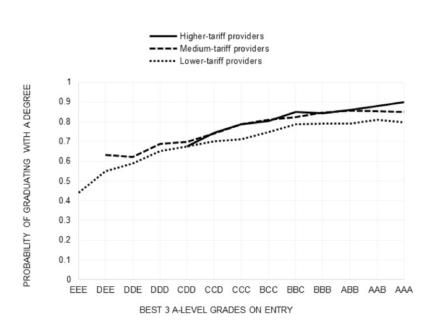Applicants to higher education from less advantaged backgrounds are much less likely than others to achieve the high academic entry qualifications usually required by the most selective universities.
For example, if higher-tariff providers in England wanted to admit the highest-performing ten per cent of free school meal-eligible pupils from state schools, this would mean admitting everyone with qualifications roughly equivalent to at least BCC at A level. Similarly, if medium-tariff providers wanted to admit the next highest-performing ten percent of free school meal-eligible pupils, this would mean admitting everyone with DDD and above at A level.
It will be therefore hard to meet Office for Students (OfS) targets for near-equal representation of socio-economic groups in the most selective tiers of higher education by 2038 unless more applicants are accepted with lower prior qualifications.
This provides a clear opportunity to use a strong contextualised admissions approach, whereby lower offers are focused solely on applicants from disadvantaged backgrounds. Such a focus is justified because of the increasing evidence that, for the most disadvantaged students, prior attainment scores do not generally reflect their true potential.
Our evidence indicates that a contextualised approach to admissions, involving the reduction of academic entry requirements for disadvantaged learners, is mathematically necessary in order to achieve wider access to higher education for disadvantaged students.
Scotland has led the way in formal contextualised admissions, along with some higher education providers in other home countries, but the practice is not yet widespread, and according to research undertaken for the Sutton Trust, most reductions offered are very modest, such as just one or two grades.
Based on our evidence, we contend that three main steps are needed for a strong and fair contextualised admissions approach.
Identifying disadvantage
The sector needs to agree on a secure way of identifying those applicants who are genuinely disadvantaged, without also falsely identifying many more applicants who are not actually disadvantaged. This means using only verified individual-level measures of contextual disadvantage, such as free school meal status as confirmed by the applicant’s school, or low household income as verified by Department for Work and Pensions or HMRC records.
OfS advocates the use of the area-level indicator POLAR, which shows how high (or low) higher education participation is in any postcode. In Scotland, contextualised admissions policy is based on another area-level measure – the Scottish Index of Multiple Deprivation. Both have the same flaws, because measures based on which postcode area an applicant comes from are neither precise nor accurate.
Identification should never rely on area-level measures such as POLAR to determine who is and who is not contextually disadvantaged. Our review of available contextual indicators for use in widening participation suggests that this would be likely to create as much injustice as it prevents, or more.
For example, only 10 per cent of students who come from the 20 per cent lowest participation postcodes, according to POLAR, had been objectively disadvantaged by being eligible for free school meals at age 15. Only 12 per cent of students who had been objectively disadvantaged by being free school meal-eligible at age 15 were from the 20 per cent lowest participation post-codes. This means that around 90 per cent of applicants to higher education given contextualised consideration under OfS guidelines will be no more disadvantaged than most other applicants from other areas. Moreover, 88 per cent of the actual disadvantaged students will just be ignored by a process intended to help them. This is absurd. Other post-code measures such as SIMD, IMD, ACORN or IDACI might be slightly better, but they still will not accurately reflect the characteristics of specific individuals.
Set the right entry tariff
The second step in contextualised admissions is to set a suitable reduced entry tariff for contextually disadvantaged learners for each institution and course. The evidence suggests that this could be at least as low as BCC at A level for contextually disadvantaged learners entering higher-tariff universities.
We have looked at the range of prior qualification levels for past entries to high, medium and lower tariff institutions. It is clear that higher entry qualifications are related to higher chances of completing a degree course (and of gaining a higher class degree). But, as the graph below shows, the slope is quite flat and gets even flatter at the highest entry qualification end – meaning that the returns on higher levels of entry qualification decrease.
For example, those entering the most selective universities with BCC grades had more than 80 per cent chance of successfully completing a degree. This is higher than for even the most qualified entrants to medium- and lower-tariff institutions, and not much lower than for those entering the most selective providers with AAA grades. There is therefore considerable scope for high-tariff providers to reduce entry requirements quite substantially for the most disadvantaged students.

The relationship between prior qualification level and degree classification is similar, but slightly stronger.
Helping students to thrive
In order to ensure that a fairer admissions process also leads to fairer outcomes, the third step in planning contextualised admissions is therefore to do as much as possible to support all learners to fulfil their potential at and beyond higher education.
Of course, the higher the chances of success the better, but the precise level already varies between individuals, providers, and courses. The chances will also improve as more contextually admitted students appear in universities, and resources are used to support their progression.
The authors’ research was funded by the Economic and Social Research Council, grant numbers ES/N01166X/1 and ES/N012046/.















The authors are correct that school attainment (grades) are the primary barrier to entry to the most selective universities. This simply reflects the fact that places are scarce and these institutions have a high entry tariff. But the authors do not propose as a solution the award of contextualised A-levels. Schools and the DfE know far more about pupils than universities ever will whatever datasets are assembled. If a student achieving BCC is in fact AAA allowing for context, then would it not be better to give them AAA grades? Regardless of whether the pupil then goes on to university,… Read more »
These are good points, and use of context at earlier stages would be desirable, including age-in-year for KS2 assessments. And of course the biggest stratification by poverty and SEND comes at the end of KS4 in England. Solve these, as we are continuously trying to do, and contextualised admission to HE for the minority is no longer needed. A stop-gap approach – but likely to be needed for several years yet!
Agree that FSM is far superior to POLAR, however I don’t think we should ignore the influence of geographical location as well.
If the latest DfE data is to be believed it would appear that free school meals pupils in London are more likely to progress to university than non free school meals pupils in the South West of England, for example. If FSM is holding people back more in certain geographical areas, then maybe looking at the intersections of socioeconomic factors and geographical factors is fairest?
No. This is a misunderstanding. We cannot use area measures – ever – for the reasons given. We should use how long individuals have been FSM-eligible because this varies considerably by region, and produces the kind of results you cite.
https://journals.sagepub.com/doi/full/10.1177/2158244018825171
“For example, those entering the most selective universities with BCC grades had more than 80 per cent chance of successfully completing a degree. This is … not much lower than for those entering the most selective providers with AAA grades.”
And, to carry this line of reasoning a step further, those entering with DEE grades are not much lower than those entering with BCC grades.
The point is: a difference of 10% is actually huge when you are talking about “completing a degree”.
Looks interesting, I shall take a read.
The article (and, from what I can tell by a quick skim through, the underlying research) doesn’t seem to account for one very important factor. Students with low grades that get admitted to highly selective universities aren’t typical of the average student with those grades. Universities already try to look at context and mitigating factors to assess a student’s true potential. If a top university is admitting a student with BCC there must be a reason for that; the article’s conclusion seems to be falling into the trap of assuming that all BCC students have the same level of potential.… Read more »
“A stop gap approach”. Could you elaborate? Is it that the DfE can’t give BCC students AAA because it is impossible. Or could DfE require exam boards to lift grades but chooses not to do so? It is unclear whether you are advocating that universities do the impossible or that they do with limited data what the DfE could itself do with good data. Universities could raise the degrees awarded for some students based on their knowledge monitoring these students on course. But you are not advocating they in fact do this. Instead you are arguing that prior qualification is… Read more »